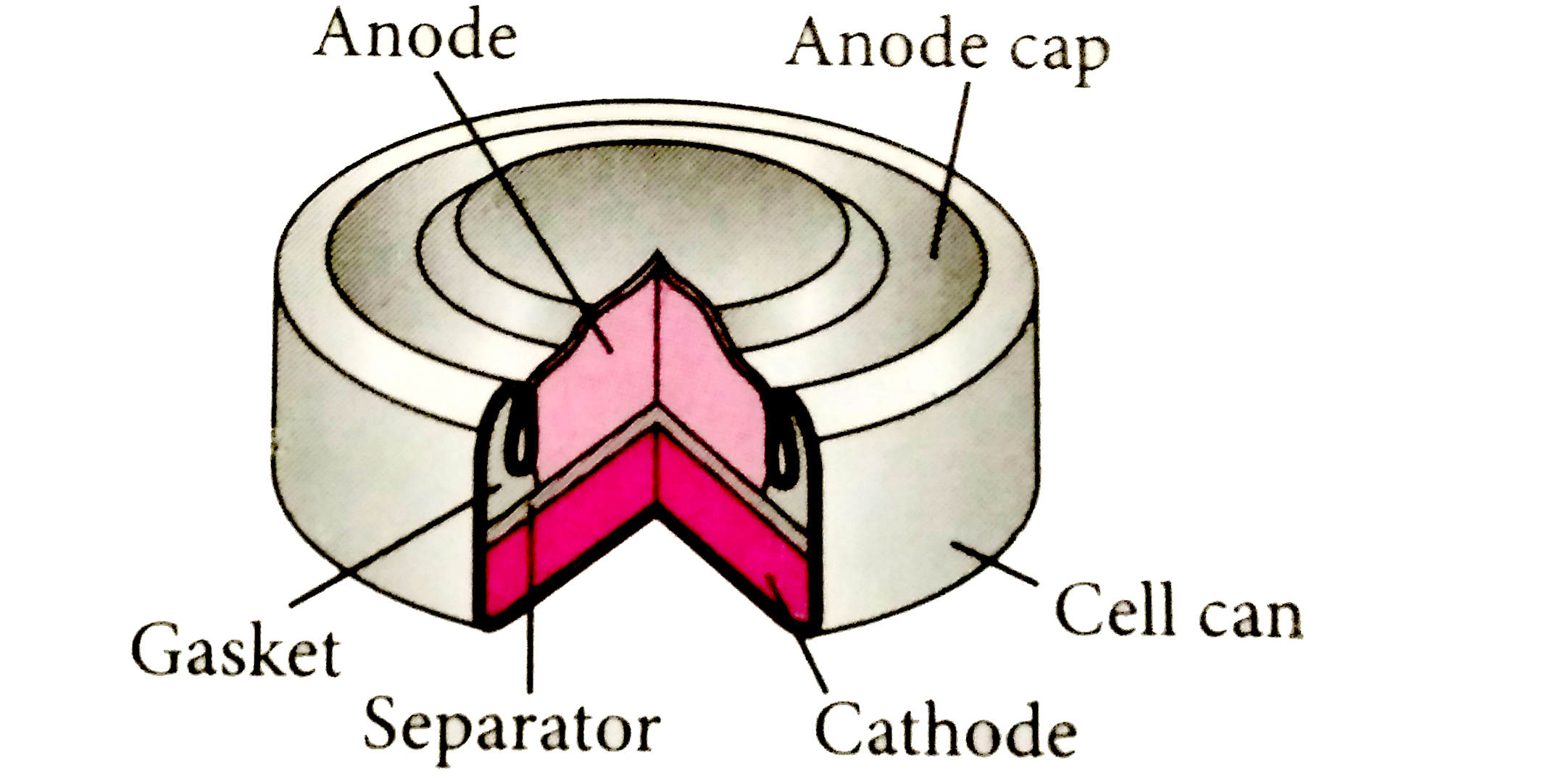Assertion:In mercury cell, the cell potential is approximately 1.35 V Which cell will measure standard electrode and remains constant during its life.
Reason : The overall reaction in mercury cell is represented as Zn(Hg)+HgO(s)→ZnO(s)+Hg(l)
If both assertion and reason are true and reason is the correct explanation of assertion .
If both assertion and reason are true but reason is not the correct explanation of assertion .
If assertion is true but reason is false .
If both assertion and reason are false .
The correct Answer is:A
To solve the given question, we need to analyze both the assertion and the reason provided.
Step 1: Understand the Assertion
The assertion states that in a mercury cell, the cell potential is approximately 1.35 V, and it remains constant during its life.
- Analysis: The mercury cell, also known as the zinc-mercury oxide cell, indeed has a standard cell potential of about 1.35 V. This potential is stable throughout the life of the cell because the reactants and products do not change in concentration significantly over time.
Step 2: Understand the Reason
The reason given is that the overall reaction in the mercury cell is represented as:
Zn(Hg)+HgO(s)→ZnO(s)+Hg(l)
- Analysis: This reaction shows that zinc amalgam (Zn(Hg)) reacts with solid mercury oxide (HgO) to produce solid zinc oxide (ZnO) and liquid mercury (Hg). In this reaction, there are no ions in solution whose concentrations would change over time. Therefore, the potential of the cell remains constant.
Step 3: Evaluate the Correctness of Assertion and Reason
- Both the assertion and the reason are correct. The assertion is true because the cell potential is indeed approximately 1.35 V and remains constant. The reason is also true because the reaction does not involve ions that would change concentration, thus maintaining a constant potential.
Conclusion
Both the assertion and reason are correct, and the reason provided is the correct explanation for the assertion.
Final Answer
Both assertion and reason are true, and the reason is the correct explanation of the assertion. Therefore, the correct option is A.
---
The assertion states that in a mercury cell, the cell potential is approximately 1.35 V, and it remains constant during its life.
The reason given is that the overall reaction in the mercury cell is represented as:
Zn(Hg)+HgO(s)→ZnO(s)+Hg(l)
- Both the assertion and the reason are correct. The assertion is true because the cell potential is indeed approximately 1.35 V and remains constant. The reason is also true because the reaction does not involve ions that would change concentration, thus maintaining a constant potential.
Both the assertion and reason are correct, and the reason provided is the correct explanation for the assertion.
Both assertion and reason are true, and the reason is the correct explanation of the assertion. Therefore, the correct option is A.
Topper's Solved these Questions
- ELECTROCHEMISTRYBook:NCERT FINGERTPS ENGLISHChapter:ELECTROCHEMISTRYExercise:Electrochemical Cell
Explore 1 Video
- ELECTROCHEMISTRYBook:NCERT FINGERTPS ENGLISHChapter:ELECTROCHEMISTRYExercise:Galvanic Cell
Explore 19 Videos
- ELECTROCHEMISTRYBook:NCERT FINGERTPS ENGLISHChapter:ELECTROCHEMISTRYExercise:EXEMPLAR PROBLEMS
Explore 17 Videos
- COORDINATION COMPOUNDS Book:NCERT FINGERTPS ENGLISHChapter:COORDINATION COMPOUNDS Exercise:Assertion And Reason
Explore 15 Videos
- GENERAL PRINCIPLES AND PROCESSES OF ISOLATION OF ELEMENTSBook:NCERT FINGERTPS ENGLISHChapter:GENERAL PRINCIPLES AND PROCESSES OF ISOLATION OF ELEMENTSExercise:Assertion And Reason
Explore 15 Videos
Similar Questions
Knowledge Check
Which cell will measure standard electrode potential of copper electrode?
APt(s)|H2(g,0.1bar)|H+(aq,1M)∣∣∣Cu2+(aq,1M)∣∣CuBPt(s)|H2(g,1bar)|H+(aq,1M)∣∣∣Cu2+(aq,2M)∣∣CuCPt(s)|H2(g,1bar)|H+(aq,1M)∣∣∣Cu2+(aq,1M)∣∣CuDPt(s)|H2(g,1bar)|H+(aq,0.1M)∣∣∣Cu2+(aq,1M)∣∣CuThe cell reaction of the galvanic cell : Cu(s)∣∣Cu2+(aq)∣∣∣∣Hg2+(aq)∣∣Hg(l) is
AHg+Cu2+→Hg2++CuBHg+Cu2+→Cu++Hg+CCu+Hg→CuHgDCu+Hg2+→Cu2++HgFor a cell reaction : Mn+(aq)+ne−→M(s), the Nernst equation for electrode potential at any concertation measured with respect to standard hydrogen electrode is represented as
AE(Mn+/M)=E∘(Mn+/M)−RTnFln(1[Mn+])BE(M/Mn+)=E∘(M/Mn+)−RTnFln([Mn+][M])CE(Mn+/M)=E∘(Mn+/M)−RTnFlog1[M]DE(Mn+/M)=E∘(Mn+/Mn+)−RTnFln[Mn+]
Calculate the standard potential of the cell ,If the standard electrode potentials of Zn2+/ZnandAg+/Ag are -0.763 V and + 0.799 V respectively .
View SolutionThe standard emf of a galvanic cell involving 2 motes of electrons in its redox reaction is 0.59 V the equilibriun constant for the redox reaction of the cell is
View SolutionWhich of the given statements for mercury cell are incorrect?

(i)Mercury cell is suitable for low current devices like hearing aids, watches, etc.
(ii)It consists of zinc-mercury amalgam as anode and a paste of HgO and carbon as the cathode.
(iii)The electrolyte is a paste of Zn(OH)2 and KO2.
(iv)The electrolyte reactions for the cell are At anode : Zn(Hg)+H2O→ZnO(s)+2OH−+2e−
At cathode : HgO+H2O+2e−→Hg(l)+2OH−
View SolutionMention the reaction occurring at (i) anode, (ii) cathode, during working of a mercury cell. Why does the voltage of a mercury cell remain constant during the operation?
View SolutionThe standard electrode potential for Daniel cell is 1.1V. Calculate the standard Gibbs energy of the reaction (In KJ/mol)
Zn(s)+Cu2+(aq)→Zn2+(aq)+Cu(s)
View Solution